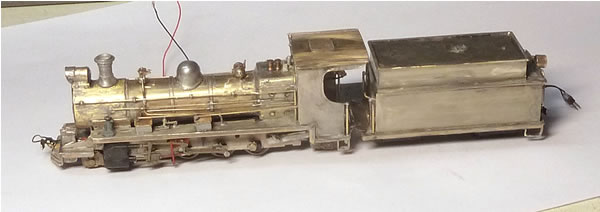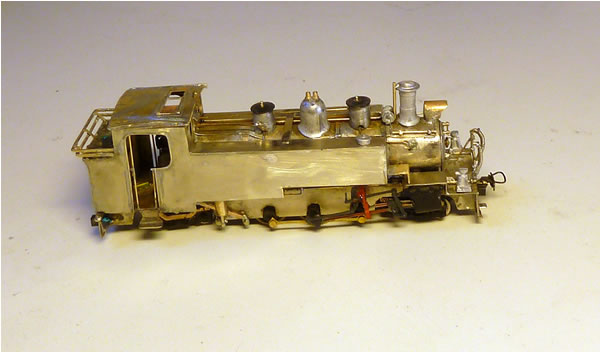|
The beauty of brass

“All dust is the same
dust.
Temporarily separated
To go peacefully
And enjoy the eternal nap.”
― Dejan Stojanovic
That is possibly true, but
what do you think will last the longest; a plastic model or one properly
built in brass or nickel silver? Plastic has a habit of gradually losing its
properties and becoming brittle. This is because the molecules begin to join
up with those alongside: this is called polymerization. The phenomenon is
accelerated by exposure to ultra violate light but will happen all on its
own, given time. I have a drawer full of old plastic chassis parts that have
cracked and become useless. I doubt I am the only one.
Pick up a locomotive made of
plastic and it will feel not too different to a child's toy straight from
Mothercraft'.

A ready to run well detailed
plastic model locomotive may well look the part and no doubt will outlive
some of us old duffers but will you feel a sense of satisfaction when you
handle it? Add to this the question of ballast weight. Model locomotives
need to be heavy to prevent the driving wheels from slipping. It is of
course possible to add traction tyres to mitigate this but it comes at the
cost of reliability and loss of electrical pickup.

Then, of course, there is
the emotional reaction. Steam engines are heavy and robust things made of
metal. For me, I like my models to be the same! I just cannot accept that
bits of plastic stuck together is a robust solution.
So why is it that less and
less modellers learn to solder and make 'proper' model locomotives?
I think some of it is that
some are fearful of learning new skills although soldering is very straight
forward. Health and safety does not help matters either. As soldering flux
gets 'safer' and 'safer' it also becomes less and less effective. I still
use Bakers fluid which always works. The other problem is that many solders
are now lead free and are completely hopeless and last but a short time
before breaking up.
see
art of soldering
So what is so mysterious
about building in brass?
Absolutely nothing but some
still make a huge meal of the whole affair. The principles were laid down by
John Ahern in his book 'Miniature Locomotive Construction' back in the 1950s
and it has just become easier and easier since then. Nowadays, a vast
selection of brass sheets, sections and tubes are available from suppliers.
A huge choice of castings can be purchased both in lost wax brass and white
metal. Modern simple power tools complete the picture.
soldering
The first thing is to make
sure that you get enough heat to the work QUICKLY. Many people use far too
small irons and manage to unsolder everything else before succeeding in
getting the area to be soldered hot enough. For most loco building, one
needs three irons: 40, 25 and 18 watt. It is useful to have a choice of tips
that can easily be interchanged. I see little point in expensive temperature
controlled units and just buy cheap Antex units from Expo Tools.
Flux which works is also
essential. I use Bakers soldering fluid No 3. I pour a little in a jar and
apply it with a brush. It is strong and one must not get it on one's face.
The work needs to be washed regularly with hot water and detergent as does
one's hands.
Solder MUST be proper lead
based solder. This is still available in proper electronics suppliers. Lead
free solder breaks down into powder in very little time and solders very
badly in any case.
practice
If you have not soldered
before, practice first on bits of brass and learn how to get a good joint
without excess solder. If the work looks like bird droppings, you are not
using the right flux or have insufficient heat to the work.
It is then worth while
starting to build a simple etched brass kit and work up from there. Bit by
bit, one collects a lot of spare etches and parts from early failed
projects. These become invaluable later as ready made parts for new locos.
tools
The only power tool I use is
a Zircon mini drill and regulator bought from Expo Tools. It is the only one
I have found to be any good but still needs a spot of maintenance and I
occasionally have the replace the motor, which costs just a few pounds. When
loco building, it is in use almost all of the time. I use a selection of
burrs, minidrills and Proxon cut-off discs and sanding discs. I cut
most of my metal with this tool and do most of my building using it. I hate
doing things by hand when power tools will do the trick.
I also have a metal bender
which is just two stout bars which one can screw together, and a selection
of small files, screwdrivers and engraver's chisels. I also have 10 and 12
BA taps which are heavily used.
I have a small vice and a
few other bits and pieces but no more than the average modeller. There is no
excuse not to build in brass!
Perhaps also there is a
current trend of instant gratification which usually results in no
gratification at all. Metal locomotives are just as fast to build once the
skills are learned and are things that will last through generations.

This Gwalior Mikado was built in one week based on a Grafar class 08 chassis

This Baltic was constructed in 6 days from scratch
Many etched brass kits are
available from small suppliers but few tackle the easy task of putting one
together. This is more so in the case of 009 narrow gauge modellers who more
often than not continue to exist in a world of plastic mediocrity. Back in
the days before electricity, an outfit called Rosebud Kitmaster brought out
a rather crude plastic kit of a Lancashire and Yorkshire Pug. 60 years
later, folks are still bashing them about to produce unconvincing facsimiles
of narrow gauge engines!

Also on the market are a
plethora of white metal kits. Most are crude and lack much detail. Most stop
at the running board and one must find an inappropriate chassis to stick
under it. A very small number do a worthwhile job and incorporate brass
etched parts as well as white metal. The Peckett produced by RM Models is a
good example.

after two days of work, a fine loco based on the Grafar 08 chassis
And now we find ourselves in
the era of 3D printing. While this might all be very clever, the spawn of
this technology is the release of dreadful looking toys covered in
corrugations which are almost impossible to remove.
Sadly, for many small scale
narrow gauge modellers, a lump of ugly plastic dumped on some antique
chassis, hidden by 'tram skirts' still appears to be the norm. In the
foreseeable future a ready to run Lynton and Barnstaple Manning Wardle, a
Minitrains Brigadelok, a Glyn Valley Tramway Beyer Peacock by Fourdees and a war department Baldwin 4-6-0 are to be
released. They will no doubt be of excellent quality and will eclipse the
usual rubbish locomotives founds on 009 layouts. Perhaps it will act
as a stimulus for building convincing models in this scale.
Somehow, though, I rather
doubt it. Apart from a few notable exceptions such as the Waller family and
Ted Polet, the best phrase to describe many adherents to this scale is 'they
are entirely satisfied with their own progress'.

the latest 3D printed offering! I rest my case

|